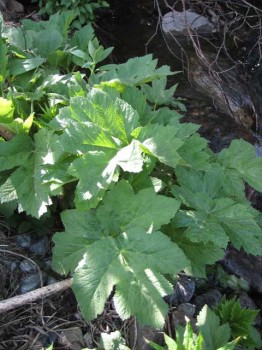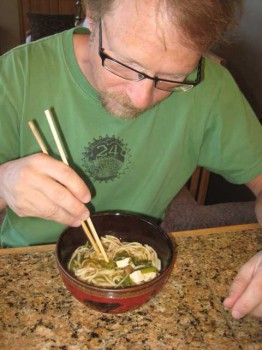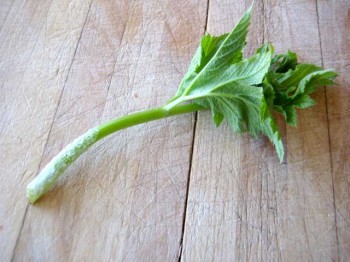
We foraged another batch of cow parsnip (Heracleum maximum) the other day. It is very plentiful where it’s plentiful, showing up in large bunches amidst the willows alongside the stream at approximately 10,500 feet where we go. Again, I reach in and snip the new, unfurling or still rolled-up leaves, petioles (leaf stalks) and all, one or two per plant.
I love the scent of cow parsnip, although both the smell and the taste are acquired—such that some authors, like H.D. Harrington, called cow parsnip “rank-smelling,” and after trying it indicated in Edible and Native Plants of the Rocky Mountains (1967) that “the taste was fair but a suggestion of the rank and unpleasant (to us) odor still lingered.”
If you’ve never tried cow parsnip before, I recommend a dish like Kathryn G. and Andrew L. March’s (1979) tried-and-true boiled cow parsnip with raw onions, butter, and soy sauce. Even with these added flavors, you get a good sense for what cow parsnip tastes like, because it certainly does have a strong taste. Unique, wild and woolly, strange, and interesting are among the adjectives that come to mind. Gregg himself was uncertain about cow parsnip for a while, but has since embraced it.

Asian-Style Cow Parsnip Soup
I was aiming for udon or pho on this one, but due to both lack of ingredients and little experience with making either of these kinds of soup, I ended up with something in between—plus cow parsnip, of course. Here’s what I did:
First, I reconstituted finely chopped dried oyster mushrooms (thanks mom) in warm water and strained, saving the flavorful liquid. Then I sautéed garlic, ginger, drops of hot chili oil, and the oyster mushrooms in olive oil and soy sauce. In a separate pot, I boiled udon noodles, strained, and set aside. In another pot I boiled the cow parsnip for ten minutes and strained, saving this flavorful liquid as well. Then I set a final pot on the stove and added cups of liquid here and spoonfuls of ingredients there like a mad scientist trying to create the perfect soup. I ended up combining the whole sauté with the cow parsnip, udon noodles, cubed tofu, oyster mushroom and cow parsnip broths (in what proportion I don’t know and will likely never be able to replicate), plus more soy sauce, fish sauce, and lime juice to taste.
In the end, the soup tasted a lot like cow parsnip.
“I love cow parsnip,” Gregg said last evening after choosing to eat the leftover soup over a fresh-made dish, making it our second night in a row dining on it. “And I think it’s a good introduction to cow parsnip—it’s not as strong as cow parsnip alone, but still the dominant flavor in the soup.”

Cow Parsnip Candy Sticks
In Nature’s Garden (2010), Samuel Thayer says to peel cow parsnip petioles (or flower stalks) and try them dipped them in sugar, of all things! So, while waiting for the mushrooms to reconstitute, I tried peeling a young petiole. It must have been too young, however, for my efforts were rewarded only with air. Instead, I decided to dip the thinnest, tenderest leaf stalks in sugar without peeling.
Oh man, can I just say—I’m addicted! To the point that I have to sneak cow parsnip petioles from the fridge when Gregg’s not looking, concerned as he is with having enough left for himself. They are mildly spicy with that same great cow parsnip taste but sweet too because of the sugar. Mmm.
I guess this means candy-making is next up on the list of culinary arts for me to master, because now I want to snack on cow parsnip candy all winter long!
Warning: Contact with cow parsnip in the sunlight while sweating can cause an irritating skin reaction. Cow parsnip should be identified carefully. Do not confuse it with toxic members of the Umbelliferae family. Also, Thayer (2010) describes a related plant, giant hogweed (H. mantegazzianum), which has become invasive in areas of Ontario, the eastern US, the Pacific Northwest, and elsewhere, that is “extremely dangerous” in terms of its potential to burn the skin and eyes. He thinks it “might” be edible, but readers should regardless exercise caution with H. mantegazzianum, which he describes as having “more deeply cut leaf lobes” and says “can grow to 16 feet in height.”For more information on cow parsnip, please see my other entries, Roadside Cow Parsnip Boiled in Tap Water, and Crazy for Cow Parsnip Again.

Cow Parsnip is related to Angelica, no? And I believe candied Angelica was a thing, back in the day.
Your site is charming and informative, by the by. Thanks!